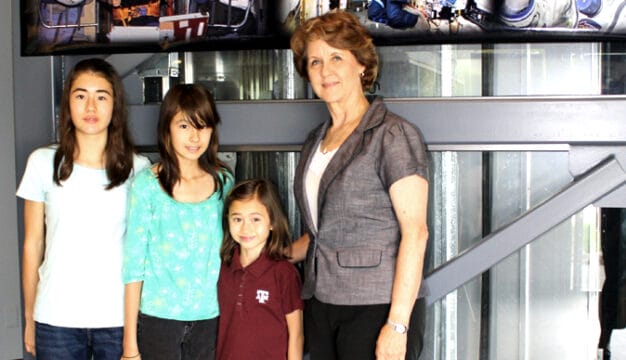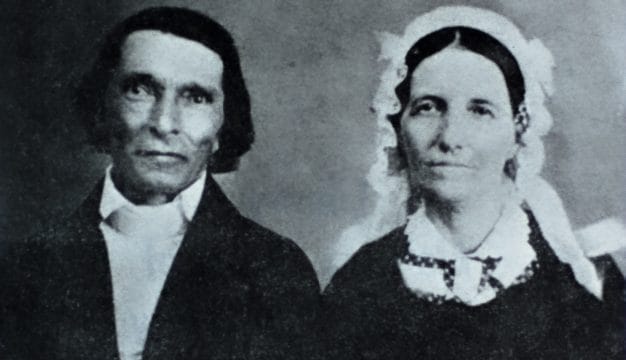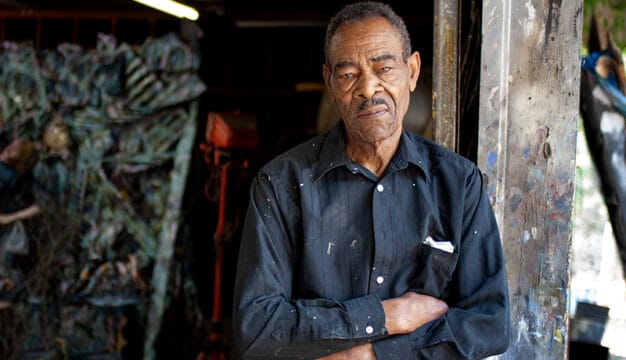Mae Carol Jemison
 Mae Jemison at Auburn University
Mae Carol Jemison (1956- ) is a physician and former astronaut who became the first African American woman to go into space. On board the Space Shuttle Endeavour (OV-105) in 1992, Jemison logged 190 hours, 30 minutes, and 23 seconds during her only mission. After retiring from the National Aeronautics and Space Administration (NASA) in 1993, she founded a technology consulting firm and other businesses, has held visiting professorships, and become involved in various scientific philanthropic organizations, including her own Dorothy Jemison Foundation for Excellence.
Mae Jemison at Auburn University
Mae Carol Jemison (1956- ) is a physician and former astronaut who became the first African American woman to go into space. On board the Space Shuttle Endeavour (OV-105) in 1992, Jemison logged 190 hours, 30 minutes, and 23 seconds during her only mission. After retiring from the National Aeronautics and Space Administration (NASA) in 1993, she founded a technology consulting firm and other businesses, has held visiting professorships, and become involved in various scientific philanthropic organizations, including her own Dorothy Jemison Foundation for Excellence.
Jemison was born on October 17, 1956, in Decatur, Morgan County, to Charlie Jemison, a maintenance worker, and Dorothy (Green) Jemison, an elementary school teacher. She was the youngest of three children. When Mae was three years old, the Jemison family moved to Chicago, Illinois, to take advantage of greater educational opportunities. From an early age, she took an interest in science, particularly astronomy. By the time she attended Morgan Park High School, Jemison had decided to pursue a career in engineering. After graduating from high school at the age of 16 in 1973, she enrolled at Stanford University, pursuing a double major in chemical engineering and African and African American Studies.
After graduating from Stanford in 1977, Jemison pursued a medical degree at Cornell University. During this time, she visited Cuba and Kenya and began working at a Cambodian refugee camp in Thailand. Jemison graduated from Cornell in 1981 and moved to Los Angeles for her residency at Los Angeles County/USC Medical Center in July 1982 and thereafter worked as a general physician with the INA/Ross Loos Medical Group until December 1982. She joined the Peace Corps and from January 1983 through June 1985, she served in Sierra Leone and Liberia, providing medical care for patients, developing curricula, and providing health training. She also participated in research projects on Hepatitis B vaccine, schistosomiasis, and rabies in conjunction with the National Institutes of Health and the Centers for Disease Control.
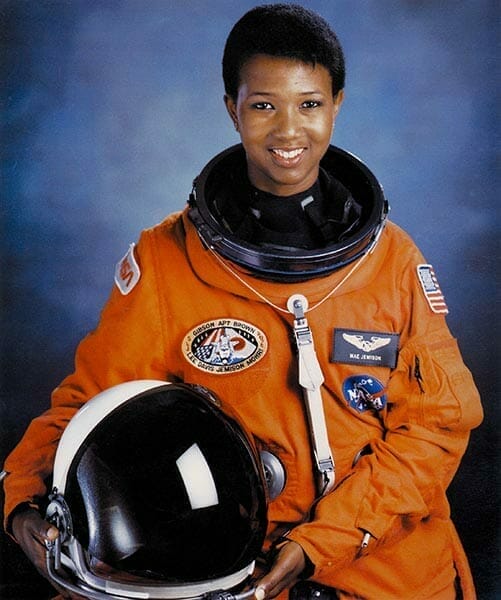 Mae Jemison
Upon her return to the United States in 1985, Jemison continued her work as a general practitioner in Los Angeles. In October of that year, after the flight of Sally Ride—the first American woman in space—Jemison applied to NASA’s astronaut program and thereafter prepared by enrolling in graduate engineering courses. The selection for the project was delayed in the wake of the Space Shuttle Challenger (OV-099) explosion in January 1986, however, so Jemison applied a year later. She was chosen as one of 15 candidates from a pool of more than 2,000 applicants to join the NASA astronaut training program and became the first African American woman in the program. During this time, her technical assignments included launch support activities at the Kennedy Space Center in Florida, verification of Shuttle computer software in the Shuttle Avionics Integration Laboratory (SAIL), and Science Support Group activities.
Mae Jemison
Upon her return to the United States in 1985, Jemison continued her work as a general practitioner in Los Angeles. In October of that year, after the flight of Sally Ride—the first American woman in space—Jemison applied to NASA’s astronaut program and thereafter prepared by enrolling in graduate engineering courses. The selection for the project was delayed in the wake of the Space Shuttle Challenger (OV-099) explosion in January 1986, however, so Jemison applied a year later. She was chosen as one of 15 candidates from a pool of more than 2,000 applicants to join the NASA astronaut training program and became the first African American woman in the program. During this time, her technical assignments included launch support activities at the Kennedy Space Center in Florida, verification of Shuttle computer software in the Shuttle Avionics Integration Laboratory (SAIL), and Science Support Group activities.
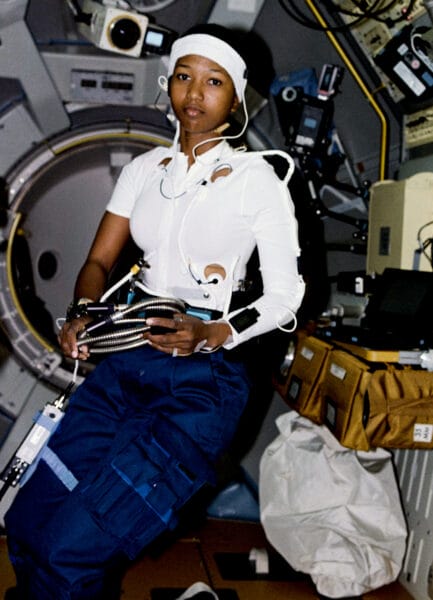 Mae Jemison Aboard Endeavour
When her training was completed, Jemison became the first astronaut with the title of Science Mission Specialist, making her responsible for conducting crew-related scientific experiments on the space shuttle. On September 12, 1992, Jemison and six other astronauts, including fellow Alabama native Jan Davis, flew into space onboard the Endeavour cooperative mission between the United States and Japan with the Spacelab, a self-contained portable laboratory developed by the Marshall Space Flight Center, in Huntsville, Madison County. Over the span of eight days, the Endeavour orbited the earth 127 times while crewmembers conducted 44 life science and materials processing experiments including weightlessness, motion sickness, and bone-cell research, several performed by Jemison. On her only mission in space, she logged 190 hours, 30 minutes, and 23 seconds in space. Jemison and the rest of the Endeavour crew returned to Earth on September 20, 1992.
Mae Jemison Aboard Endeavour
When her training was completed, Jemison became the first astronaut with the title of Science Mission Specialist, making her responsible for conducting crew-related scientific experiments on the space shuttle. On September 12, 1992, Jemison and six other astronauts, including fellow Alabama native Jan Davis, flew into space onboard the Endeavour cooperative mission between the United States and Japan with the Spacelab, a self-contained portable laboratory developed by the Marshall Space Flight Center, in Huntsville, Madison County. Over the span of eight days, the Endeavour orbited the earth 127 times while crewmembers conducted 44 life science and materials processing experiments including weightlessness, motion sickness, and bone-cell research, several performed by Jemison. On her only mission in space, she logged 190 hours, 30 minutes, and 23 seconds in space. Jemison and the rest of the Endeavour crew returned to Earth on September 20, 1992.
In March 1993, Jemison resigned from NASA and then founded the Jemison Group, a technology consulting firm that researches applications of technology in daily life. In 1999, she established the medical technology company BioSentient Corporation in Houston, Texas; the company aims to develop a portable ambulatory device that provides real-time physiologic monitoring of the involuntary nervous system. Also in Houston, Jemison founded the Dorothy Jemison Foundation for Excellence, named in honor of her mother. It is a philanthropic organization that develops and implements teaching methods, curricula, materials, and programs for students to better society through fostering critical thinking skills, using experiential teaching methods, promoting science literacy, and providing integrated approaches to learning.
From the mid-1990s into the 2000s, Jemison served as a professor-at-large at Cornell University as well as a professor of Environmental Studies at Dartmouth College. There, she taught courses on sustainable development and technology design and ran the Jemison Institute for Advancing Technologies in Developing Countries. In 2012, the Dorothy Jemison Foundation made the winning bid for the NASA-Defense Advanced Research Projects Agency’s “100 Year Starship” project for interstellar travel.
 Mae Jemison and Kathryn Thornton
The grant provides funding for research into making possible human travel beyond the solar system over the next 100 years. In September 2016, she became a leader-in-residence at the Indiana University Kelley School of Business as its Poling Chair of Business and Government.
Mae Jemison and Kathryn Thornton
The grant provides funding for research into making possible human travel beyond the solar system over the next 100 years. In September 2016, she became a leader-in-residence at the Indiana University Kelley School of Business as its Poling Chair of Business and Government.
Jemison has received numerous awards and honors including the Johnson Publications’ “Black Achievement Trailblazers Award” in 1992, and in 1993 election to the National Women’s Hall of Fame, induction into the National Medical Association Hall of Fame, and the Kilby Science Award. In 2004, she was inducted into the International Space Hall of Fame. Additionally, she has received numerous honorary doctorates. Opened in 2016, the Dr. Mae Jemison High School in Huntsville was named in her honor. Jemison appeared in a 1993 episode of the Star Trek: the Next Generation, making her the first real astronaut to appear on the television science fiction series.
